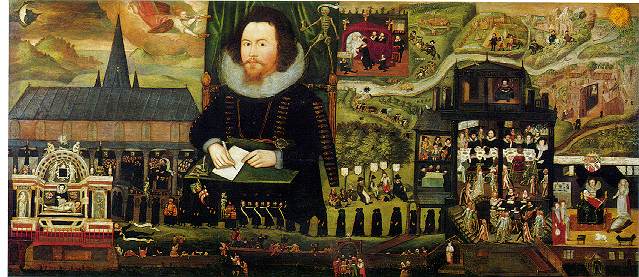The so-called Unton Memorial, in the Tudor rooms of the National Portrait Gallery, is a thoroughly intriguing bad picture. A narratively ambitious, rather dark and quaintly intricate depiction of an Elizabethan gentleman’s birth, life and death, it was created to commemorate the funeral of one Sir Henry Unton, which took place on
The Unton Memorial appears at first glance to seethe with complication but the underlying principles of its composition are fairly straightforward. At the pivotal point of the painting, just left of centre, a large portrait of Sir Henry Unton presides over a landscape in which his life, death and funeral rites unfold. He is shown writing at a table, which is probably an allusion to the prominent role which he had played in Elizabethan diplomacy; and he is flanked, above, by two allegorical figures: a skeleton signifying Death, who has now claimed him; and a winged, trumpeting personification of Fame, who promises to ensure that his good name and high reputation will persist into the future.
The same dualism of life and death, light and dark, governs the larger scheme of the picture. In the upper right-hand corner, the sun illuminates the daytime of Unton’s life and deeds, while in the corresponding place on the left side, a crescent moon sheds a somewhat fainter light on the scenes of his death. Under this night sky we see the church in which Unton was buried, his intricately carved tomb and the pinheaded, faceless congregation of those who have gathered to mourn his passing. The division between the two halves of...


